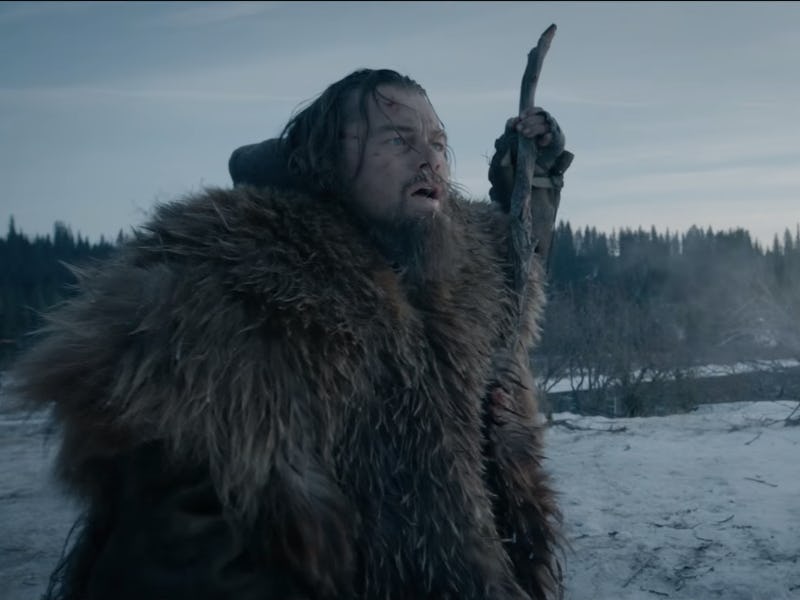Where Did the Filmmakers Shoot 'The Revenant'?
Director Alejandro G. Iñárritu dragged his crew through the Americas to make one of the most beautiful films of all time.

Nearly every article written about director Alejandro González Iñárritu’s newest movie The Revenant mentions the grueling shoot. The film, starring Leonardo DiCaprio as American frontiersman Hugh Glass, who sets out for revenge after being left for dead following a bear attack, is already the stuff of legend. The production stopped and started from September 2014 to late August 2015 because of a wide range of on-set problems: tensions between actor Tom Hardy and Iñárritu and the Ahab-like decision to use only natural light in almost all its exterior shots. The results are undeniably gorgeous, but the trials of the production wound up mirroring those of the real-life protagonist.
Glass really was mauled by a bear in what is now Perkins County, South Dakota in August 1823. Fearing for their own safety and unable to carry him with them, Glass’ men abandoned him to die. But he lived. He dragged himself and his festering wounds nearly 100 miles, to Fort Kiowa, the nearest post along the Missouri River to exact revenge. For all the toil and pain that went into the movie, it succeeds in immersing the audience, in part due to Iñárritu finding pristine exterior locations.
He tasked his collaborators, including Oscar-winning cinematographer Emmanuel Lubezki, Oscar-winning production designer Jack Fisk, and about a dozen location managers to find and create the perfect sites to capture Glass’ predicament in the 19th century American wilderness. “If we ended up in greenscreen with coffee and everybody having a good time, everybody will be happy, but most likely the film would be a piece of shit,” the director told The Hollywood Reporter. And it’s obvious that each grueling scene must have been hell to capture. “We found ourselves submerged deep in nature with all of its complications and all the beauty that it gave us cinematically,” DiCaprio said during his Golden Globes speech last night.
Those complications and that beauty mostly occurred in Alberta, Canada, Montana in the U.S., and at the southernmost tip of Argentina. Here are some of the highlights.
Kananaskis Country
The Canadian Rockies, west of Calgary.
The film used this location, an area of Canadian national parks to the west of Calgary made up of foothills and parts of the Canadian Rockies.
Stoney First Nations Reserve
DiCaprio during the attack scene that opens the film.
The Arikara Native American attack that opens the film was actually filmed in Morley, Alberta, a First Nations settlement within the land part of the Stoney Nation.
Bow Valley
The fort set (left) built by production designer Jack Fisk and his team.
This area in Alberta was used as the location for the main fort set as well as a teepee village along an area called Spray Forks Road.
Fortress Mountain
DiCaprio with the non-CGI avalanche in the background.
The production had to pack up all its equipment, including a massive crane, to capture shots on Fortress Mountain in Alberta. They also used explosives to cause an actual avalanche, which was captured in a scene with DiCaprio in the movie.
Canadian Badlands
Hardy's character sees a meteor in front of the Drumheller badlands.
The production shot scenes in Drumheller, an area northeast of Calgary in the Canadian Badlands known as the “Dinosaur Capital of the World” because of its unique geological striations. They can be seen in the movie in the scene where Hardy’s character, Fitzgerald, sees a meteor streaking across the sky.
Upper Squamish Valley
Alberta wasn’t the only Canadian province to house the production of The Revenant. The movie shoot moved to British Columbia’s Upper Squamish Valley for certain scenes, including an area along the Squamish River known locally as the “Derringer Forest” where the infamous bear attack scene was filmed. An area called Shovelnose Creek was used for the scene where the fur trappers attempt to carry Glass over a sandbar. A scene featuring the 20-man trapper camp was filmed along a service road near the Squamish River.
Kootenai Falls
Kootenai Falls, one of the largest free-flowing waterfalls in the northwest U.S.
After Canada the production moved south, but not that far south. For the scene in which DiCaprio’s character is hunted by Native Americans and flees down a waterfall the production shot at Kootenai Falls near Libby, Montana. Meryl Streep and Kevin Bacon fans will recognize the location, which was also used in the 1994 film The River Wild.
Tierra del Fuego, Argentina
DiCaprio in the climactic scene of 'The Revenant.'
Having already dragged his crew through mountains, avalanches, forests, and waterfalls, Iñárritu had to make one final move to capture pristine locations: Schlepping the entire mess down to the tip of South America. The director wasn’t simply out of winter. “The snow melted down, literally, in front of our eyes,” Iñárritu told Grantland in July. Within a month, the director moved the production to Ushuaia in Argentina. The film’s premiere was, by then, just five months away. “We were planning to shoot the ending scene in a location that supposedly will have snow,” he continued. “So we had to shut down.” That climactic confrontation between Glass and Fitzgerald? Yeah, that took place about 700 miles from Antarctica.